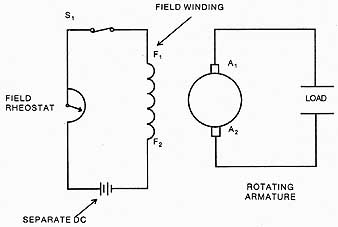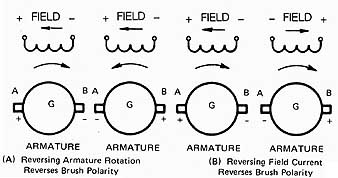AMAZON multi-meters discounts AMAZON oscilloscope discounts
OBJECTIVES
• explain the relationship of field current, field flux, and output voltage for a separately-excited dc generator.
• describe the effects on the brush polarity of reversing the armature rotation and the field current.
• define residual flux and residual voltage.
• draw and explain the basic circuit.
• connect the generator.
The separately-excited dc generator has few commercial applications, but a knowledge of its operations is an excellent background for understanding other types of generators.

Ill. 1 Separately-excited dc generator connections:
field rheostat; rotating armature; field winding

Ill. 2 Factors affecting brush polarity: (A) Reversing
Armature Rotation Reverses Brush Polarity; (B) Reversing Field Current
Reverses Brush Polarity
Using a separate source of dc power, S1 is closed as in figure 1, as dc current flows through the coil of wire wound around the iron core, a magnetic field is produced. The amount of field current is controlled by the resistance of the field winding and the variable resistor, known as the field rheostat. By adjusting the field current, the strength of-the magnetic field is controlled. The field flux or magnetic strength of the magnetic poles is increased as the field current is increased until magnetic saturation occurs. Saturation of the magnetic field means that no more magnetic flux can be produced even with an increase in field current. The magnetic polarity of the field poles is controlled by the direction of the dc field current.
The output voltage of the generator is developed as an induced voltage in the armature conductors. This induced voltage appears at the brushes and the generator output terminals designated as A1 and A2 in ill.
The output voltage is directly proportional to the speed of the rotation and the strength of the magnetic field. As the speed of the rotor is increased, the output voltage will also increase. There is, however, a limit to the safe operating speed of the rotor before physical damage occurs. Likewise, the output voltage can be controlled up to a point by adjusting the field current.
BRUSH POLARITY
When the armature is driven in either direction, an electrical polarity is established at the generator output terminals and at the brushes. If the machine is stopped and then driven in the opposite direction, the field flux is cut in the opposite direction and the brush polarity changes, as in figure 2A.
If the direction of rotation isn't changed and the field current is reversed, the same effect is obtained; that's , if the armature conductors maintain a rotation in one direction and field flux is established in the opposite direction, then the brush polarity also changes, as in figure 2B.
As a result, the brush polarity in a separately-excited generator can be changed by reversing the rotation of the armature or the direction of the field current. However, if both the armature direction and field current change, the brush polarity would remain the same (unchanged).
OUTPUT VOLTAGE
The magnitude of the voltage depends on the rate at which the flux is cut. In a separately-excited generator, an output voltage increase is proportional to an increase in the armature speed. The upper limit of the voltage is determined by the permissible speed and the insulation qualities of the armature and the commutator.
The output voltage of a separately-excited generator can be varied by adjusting the speed of the armature rotation or the field current. A change in speed always results in a corresponding change in output voltage. An increase in field current increases the output voltage only if the field poles are not saturated. Field control of the output voltage is accomplished by varying the total resistance of the field circuit with a field rheostat, as illustrated in 1.
RESIDUAL VOLTAGE
If the field circuit's opened at S1 ( 1 ) the field current becomes zero. A small amount of magnetic flux called residual flux remains, which is caused by residual magnetism. The small voltage generated when the armature cuts this flux is called residual voltage. Brush polarity remains the same when the field current is zero because the residual flux has the same direction as the main flux. If the armature is rotated in the opposite direction, the same residual voltage is obtained at the same speed but the brush polarity reverses. If the field circuit's closed momentarily and the battery connections are reversed, the residual flux reverses and the brush polarity reverses.
SUMMARY
Generation of dc voltage depends on three factors: a magnetic field, motion, and conductors. Separately-excited generators use a separate dc voltage to control the source of field excitation. By increasing the field current, field flux can be increased. By control ling the direction of field current through the coils, the magnetic polarity is established.
Output voltage level is controlled by the speed of the rotating armature and strength of the magnetic field. The polarity of the output voltage is controlled by the direction of rotation of the armature and the direction the magnetic field.
QUIZ
A. Select the correct answer for each of the following statements.
1. A separately-excited dc generator has the field connected:
a. across the armature.
b. in series with the armature.
c. to an external circuit.
d. none of these.
2. F1 and F2 generator terminals are:
a. shunt field leads. c. armature leads.
b. series field leads. d. commutating pole leads.
3. The voltage of a separately-excited dc generator may be increased by:
a. increasing the speed of rotation of the armature.
b. decreasing the magnetic flux.
c. both a and b.
d. neither a nor b.
4. The function of brushes on a generator is to:
a. carry the current to the external circuit.
b. prevent sparking.
c. keep the commutator clean.
d. reverse the connections to the armature to provide dc.
5. Electrical polarity at the brushes may be changed by:
a. reversing the rotation of the armature.
b. reversing the direction of the field current.
c. either a or b.
d. neither a nor b.
B. Select the correct answer to questions 6 to 9 from the following list and write it in the space provided (print this page as necessary).
- power source
- always
- speed of the armature
- only one
- strength of the field flux
- either
- decrease
- sometimes
- increase
6. In addition to armature rotation, the output voltage varies with the ___.
7. One factor limiting an increase in output voltage is the ___
8. A change in the speed of rotation of the armature_________ results in a change in the output voltage.
9. If the field poles are saturated, an increase in the field current does not cause a(an) __________ in the output voltage.